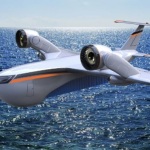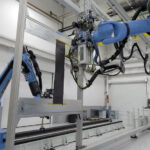The Shango is an aircraft concept envisioned to ferry 40-foot-long intermodal containers across Africa, the Mediterranean, and other seas where trade routes are interrupted. It would be capable of vertical take-off to access most regions of this vast continent, and would be used to deliver medical supplies and other goods rapidly. The name Shango comes from African mythology as the god of storm.
How it works
To take off vertically, the Shango would use pivoting ducted fans placed over and in front of the wings. The engine that comes to mind for this job would be the Rim-rotor Rotary Ramjet Engines, developed by three PhD students from the the University of Sherbrooke. The ramjets produce significant thrust and therefore deliver large amounts of rotating power.
To reduce the total weight, it has been developed a new generation of ultra light containers (ULC) made of ultra-strong composite materials. These intermodal containers would have the same external dimensions and features as existing shipping containers, designed with logistics in mind, so they could be used on ships, trains, and with the Shango.
The ULC would be loaded under the body. The aircraft would back up over the container or the container would be rolled under the aircraft. This way, in the unlikely event of the aircraft needing to shed some weight rapidly, the container could be jettisoned without loss of the craft. The ULC could also be lowered while the craft hovered over hard to land areas.
What it’s used for
The Shango could be used to deploy medical or emergency food supplies in Africa or to ship goods to remote villages where there is no airport, especially if there has been a disaster like an earthquake, volcanic eruption, or severe drought. This concept is still its in an early stage, lots of systems needs to be revised like landing positions, wings etc. It will most probably evolve into a ground effect vehicle with lower wings, revised configuration and a modified body.
The designer
The Shango aircraft concept was developed in collaboration with Ashish Thulkar an Industrial Designer from Bengaluru, India. He graduated with a master’s degree in design from the Indian Institute of Science in 2014 and currently works as a freelance vehicle designer.














